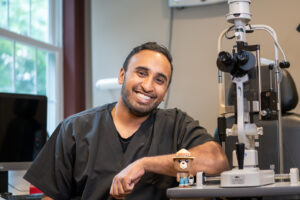January 15, 2024
By Tobin Ansel, OD, MS, FAAO
Implementing myopia management into practice is a process, and it starts with something I harp on whenever I lecture to colleagues — education. The practice should live and breathe myopia management.
 My introduction to myopia management was quite coincidental. I was fit into orthokeratology lenses in 2005 for vision correction alone, before it was widely known that OrthoK lenses could impact myopic progression. I continued with these lenses over the years (who would have thought you do not sleep much in college!) and am still a current wearer.
My introduction to myopia management was quite coincidental. I was fit into orthokeratology lenses in 2005 for vision correction alone, before it was widely known that OrthoK lenses could impact myopic progression. I continued with these lenses over the years (who would have thought you do not sleep much in college!) and am still a current wearer.
Fast forwarding to my time attending SUNY Optometry, myopia management made its debut in my professional life as I completed my MS in vision science with a focus on myopic progression and interventions in an animal model. My time in this research lab ignited my passion for both research and myopia management.
Implementing Myopia Management
I currently practice at Somerset Eye Care, located in Central New Jersey, about one hour from New York City. I have been practicing here in New Jersey since completing my residency in 2017.
I implemented the myopia management program upon joining Somerset Eye Care, and it was not an effortless process. From developing resource materials to talking confidently to parents and patients, it was quite an uphill battle when I first started. As I reflect, there were two catalysts that precipitated the program’s success. First, was the unwavering support from Somerset Eye Care’s practice owners (now partners). Their words of encouragement and investment as I strived to grow the program were invaluable. Second, attending the Vision by Design (VBD) meeting helped me go “all-in” on myopia management. Prior to attending, I had a few myopia management patients and was still struggling to communicate with myopic children and their parents. After VBD, I was motivated to take myopia management to the next level. There is something to be said about being in a room filled with people who share your passion. I knew then that this specialty was something I wanted to devote a significant amount of my energy towards.
Knowing What to Prescribe
I provided three myopia management treatment options from the beginning — OrthoK lenses, soft multifocal lenses, and atropine drop therapy. Every child is unique, and I tailor the program to their needs. When they are eligible for all treatment options, my primary recommendation is OrthoK lenses. They provide excellent myopia control efficacy and the ability to not wear glasses during the day. This is a huge benefit for students who are active in sports, particularly swimming. In some instances, I may prescribe dual therapy. This is generally for rapidly progressing children who do not respond as much as I would like on monotherapy.
There are several materials manufacturers that I use for myopia management. For OrthoK, we use Euclid, Eyespace, Abiliti Overnight, and Wave lenses. We also utilize both NaturalVue 1 Day and MiSight 1 day lenses for myopia management when a soft lens is required.
The two pieces of equipment that my experience has shown me provide the most value to the myopia management program are the Medmont Meridia and the Zeiss IOLMaster. The Medmont provides excellent, detailed topography for better OrthoK lens designs. The more accurate the topography, the better the lens fit will be. The Zeiss IOLMaster measures axial length. Axial length is an important measure when dealing with myopic progression. In conjunction with refraction, axial length provides additional data on progression. I often see axial length progression preceding refractive changes. Having this measurement allows for more timely adjustments to treatment as needed.
For both treatments and equipment, each manufacturer has strengths and weaknesses. Being familiar with several companies allows greater flexibility in finding the right fit for the patient in my chair.
Prioritizing Education
Implementing myopia management into practice is a process, and it starts with something I harp on whenever I lecture to colleagues — education. Educating every parent and patient who walks through the door about myopia management is huge. The practice should live and breathe myopia management. I try to inform every patient who comes in, even if they are not myopic and even if they do not have kids. The more you put out that the practice, and you specifically as a practitioner, are all about myopia management, the more patients will find you. Keep in mind that myopia management, on the whole, is still a new concept to most parents. It may take a year or two of hearing the benefits (and seeing their child’s myopia progress) before parents decide to move forward.
Providing Preventative Care
I am fortunate enough to also work as an attending at the West Haven VA Hospital, where I completed my residency. Working at the VA, I regularly encounter retinal detachments, glaucoma, and myopic maculopathy. As we know, these are the same diseases we are trying to prevent when being proactive with myopia management. When I have a patient with a retinal detachment, and I look over at their refractive error and see -8.00D, it hammers home the importance of providing myopia management to our young patients.
As providers, we always aim for preventative over reactive medicine. This is evidenced by our recommendation of UV protection before the onset of cataracts and AMD, or prescribing ocular hypotensive agents for patients with elevated IOP without glaucomatous damage. The difficulty with myopia is the time gap between the onset of myopia and the onset of complications. Feeling the same sense of urgency becomes more challenging when there is a 50-year delay between insult and complications. As myopia management care continues to grow, I look forward to the near future, where providers will recommend myopia care the same way we recommend a pair of sunglasses for UV protection.
 |
Dr. Tobin Ansel graduated from graduated from the University of Pittsburgh with degrees in both neuroscience and economics, before going on to attend the SUNY College of Optometry. After suffering an eye injury in college, Dr. Ansel saw firsthand the difference that a skilled and caring doctor made in his comfort and well-being, which prompted his decision to pursue a career in optometry. Dr. Ansel has a great interest in myopia management and has done significant research in this field. He is passionate about helping his patients keep their eyes healthy and happy for life. |













